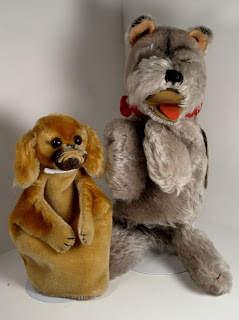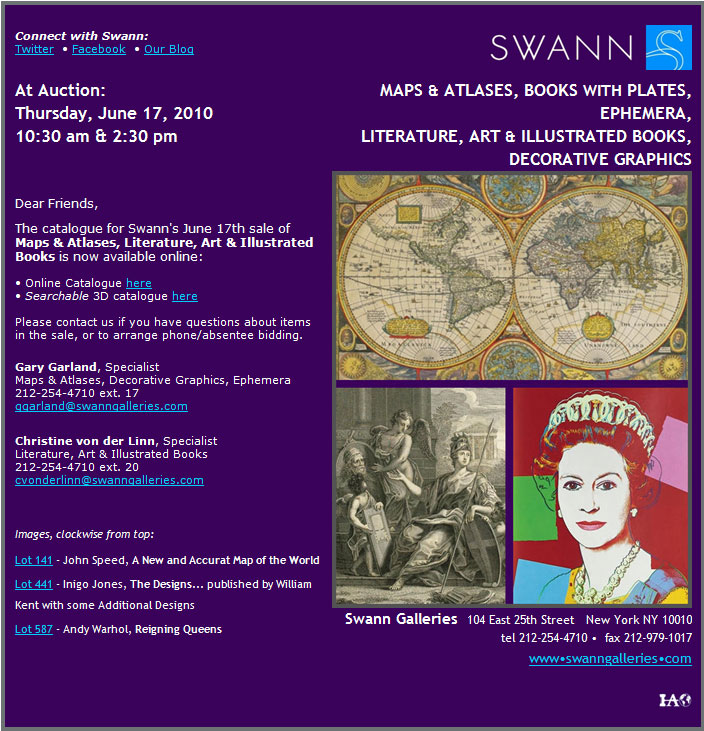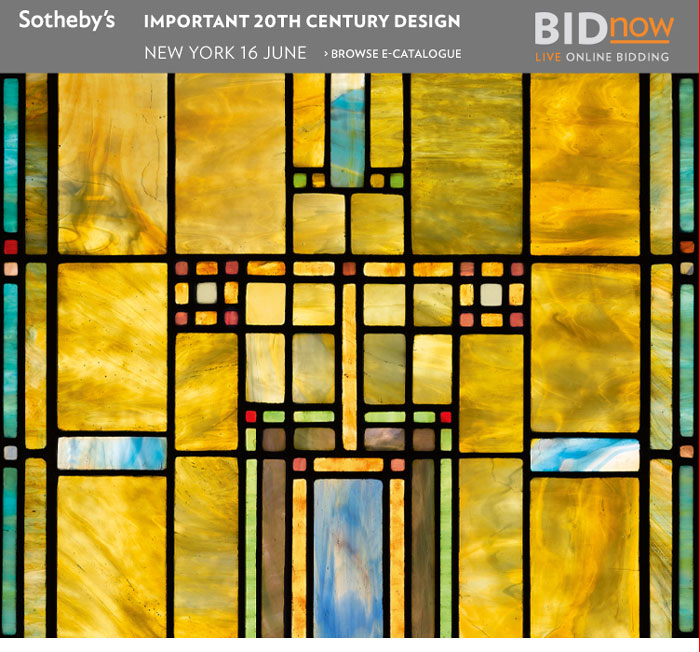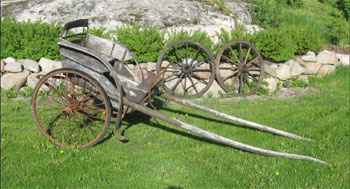Archive for May, 2010
May 29th, 2010 by admin
Swann Galleries – Maps & Atlases, Literature, Art & Illustrated Books
May 28th, 2010 by adminPicking with Reyne – Vol 5 – By Reyne Haines
May 28th, 2010 by admin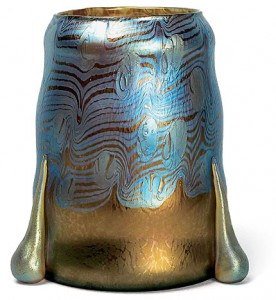 First of all, I wanted to thank everyone for reading my column and commenting on things. Your input is not only appreciated by me, but by other collectors who are reading. Your suggestions have been great, timely and informative!
First of all, I wanted to thank everyone for reading my column and commenting on things. Your input is not only appreciated by me, but by other collectors who are reading. Your suggestions have been great, timely and informative!
In last week’s column, Marko asked me a question that inspired this column. He asked: “What was my favorite find and why?”
I briefly elaborated but I thought I’d go into a bit more detail here for those who catch my reply last week.
I used to run ads in the Antique Trader. For those of you who have been in the antiques world for a long time, most dealers and collectors used to consider The Antique Trader the bible. It came out on Monday every week and we all anxiously waited for the mailman to deliver it in our mailbox.
You’d rush home, and flip to the classified section in the back to see who was selling what. This was pre eBay, pre online antique malls, digital photos, etc. (And keep the comments to yourself, I’m not that old!)
You read listings in black and white text and had to envision what people were describing, or even if what they were describing was real. Anything that sounded good, you picked up the phone and called on. Time and again I’d call on things and they were already spoken for. DRATS!
I met many pickers through this publication which was great. They went out picking all week long and would call me when they found something on my “want list”. Some could describe things to a “T” and knew exactly what I was looking for. I’d buy it just from their descriptions and rarely if ever was disappointed.
I decided I’d place a display ad in the WANTED TO BUY section of the paper. “Buying Tiffany lamps, glass, bronze and other art glass items.”
One day I was heading out to lunch and I received a phone call. I almost didn’t answer it because I was running late. I grabbed the phone and it was an elderly man on the other line saying he saw my ad in the Trader. This always got me excited. You never knew what those kinds of calls might bring.
He began describing an all too familiar piece of Steuben glass; a console bowl in amber with threading and controlled bubble decoration. It was worth about $250 and was not very exciting to me. I told him I’d call him later in the week as he was about 40 miles out of town and he wanted me to come by and see it.
I almost forgot to call him, but when I finally did I arranged to go take a look. There were a few small antique shops I hadn’t visited in some time along the way and I thought I’d make a day trip out of it.
I got to the gentleman’s house and low and behold, it was exactly the bowl I envisioned it to be. YAWN.
I decided I’d buy it as I had already driven all the way out there. Boy was I glad I did. Once I made the purchase he asked me if I bought other art glass and he pulled out a decorated tendril Loetz vase which is on the cover of one of the Loetz books. I was shocked. I asked if he was a collector, to which he said no. Of course my next question was “Did you inherit these items?” to which again he replied no. He then pointed and said “I found them in the barn in the back.”
You just never know what you might find in the barns of a country home!
I’d love to hear more about your favorite finds. Comment here with your stories!
Happy Hunting!
Reyne
Bonhams & Butterfields -San Francisco
May 28th, 2010 by adminSotheby’s – Important 20th Century Design – June 16th, 2010
May 26th, 2010 by adminLeila Dunbar to speak on June 3 as part of Cooperstown Symposium
May 26th, 2010 by admin COOPERSTOWN, N.Y. – On June 3, former Sotheby’s senior vice president Leila Dunbar will give a presentation titled “Stories In Hand – Baseball History Told Through its Memorabilia” at the National Baseball Hall of Fame in Cooperstown, New York as part of its annual symposium on baseball and American culture. The 2010 Symposium runs June 2-4, featuring lectures and panels of more than 60 baseball academics and presenters discussing baseball’s effect on American culture.
COOPERSTOWN, N.Y. – On June 3, former Sotheby’s senior vice president Leila Dunbar will give a presentation titled “Stories In Hand – Baseball History Told Through its Memorabilia” at the National Baseball Hall of Fame in Cooperstown, New York as part of its annual symposium on baseball and American culture. The 2010 Symposium runs June 2-4, featuring lectures and panels of more than 60 baseball academics and presenters discussing baseball’s effect on American culture.
Dunbar’s talk will focus on the stories behind selected rare pieces from her $36 million of Sotheby’s sports memorabilia sales, Antiques Roadshow televised sports memorabilia segments and her current appraisal business. Items include heretofore unseen Babe Ruth signed WWI Jewish Relief campaign game tickets, the only known baseball signed by Babe Ruth, Mickey Mantle and Roger Maris; Woodrow Wilson’s own 1915 Federal League baseball pass, a 1956 signed photo of Jackie Robinson and Roy Campanella on Robinson’s last trip as a Dodger before retiring, a group of 1937 telegrams from teams to Tommy Henrich after he was declared a free agent by Commissioner Kenesaw Landis, and a collection of 1936 Olympics baseball memorabilia from the estate of Paul Amen, who later went on to a baseball and football coaching career at West Point and Wake Forest.
From 1999 to 2008, Dunbar served as director of Sotheby’s Collectibles department – sales highlights include the bat that Babe Ruth used to hit the first home run at Yankee Stadium on Grand Opening Day, 1923, for $1.25 million; the 1919 agreement selling Ruth from the Red Sox to the Yankees for $996,000; the Boston Garden parquet floor center court Leprechaun logo for $332,000; and the Heisman Trophy original mold for $248,000. Since its inception in 1996, Dunbar has been a participating appraiser on the PBS series Antiques Roadshow, with more than 45 filmed segments and more than 2,000 verbal appraisals.
In 2008, Dunbar founded her own business, Leila Dunbar LLC, preparing insurance, estate tax and donation appraisals. Clients include the United States Golf Association (USGA), the New York Yankees, the New York Mets, Floyd Mayweather Jr., the National Baseball Hall of Fame, the Country Music Hall of Fame, the Tammy Wynette Estate, Sotheby’s, Bank of America and Lloyd’s of London, as well as numerous private clients. Dunbar recently was a featured speaker at the 2010 International Society of Appraisers Conference held in Toronto, giving a presentation the “Wild and Wacky World of Appraising Sports and Entertainment Memorabilia.” The talk will also be featured as a Webinar later this year. She also recently contributed articles on historic Olympic memorabilia and “Odd Celebrity Memorabilia” to the Antiques Roadshow Insider.
Registration is $165 for participants in the Hall of Fame’s Membership Program and $175 for all others. For more information and a schedule of registration fees, contact Hall of Fame Librarian Jim Gates at 607-547-0311.
My Antique Lamp
May 25th, 2010 by adminI own an antique lamp that has brought me some annoyance over the course of my life and is not especially beautiful to look at. I have to take special care with it when I move, and I must make décor decisions with it always in mind. It may have value, but I never intend to sell it. This is a classic case of an antique lamp owning me, rather than me owning it. Is the stress we endure for an object ever worth more than the object’s value? In my case, yes. The lamp was given to my grandmother by a woman whose life she saved during the Second World War. It’s one of the best and strangest stories of my grandmothers life, and by extension, of mine. And so it’s a reminder to me– a reminder that even in this age of disposability, we still have certain things we can’t get rid of, not without losing a part of ourselves.
Charlton Hall presents their 80th Anniversary Auction on Artfact Live!
May 24th, 2010 by admin
(Boston MA) Artfact wishes to express “Congratulations” to Charlton Hall on their 80th Anniversary!
We are pleased to announce that the 80th Anniversary Auction on June 5 and 6 is available for online bidding exclusively through Artfact Live! The 2 day auction offers over 1,000 lots including: fine art, jewelry, furniture, carpets, silver, timepieces, ceramics and much more. If you can’t join the live auction action in West Columbia, South Carolina, visit , or its sister site in the UK, Invaluable.com, to login or register free to bid live online at this exceptional auction. If you’re not ready to bid, simply watch the activity live from the auction floor using the Artfact Live! console.
Highlights of the sale include:
DAY1:
The top lot of the sale is Lot 58, a beachscape by the French painter Eugene Louis Boudin (1824-1898). The oil on panel depicts a ship beached near the community of St Pierre, it is framed, signed & dated: lower right, ”E. Boudin, 93.” Bidding will begin at $24,000 for this work.
Lot 97 is a Tiffany & Co diamond engagement ring. The center is occupied by a 2.35ct emerald-cut diamond (color F-G, clarity VS1), flanked by fourteen round-cut side diamonds (0.39ctw, color H-I, clarity VS1) all mounted in platinum. The ring is signed Tiffany & Co and fits ring size 6. Bidding will open at $8,500.
DAY2:
The top lot of day 2 is a painting by native South Carolinian Elizabeth O’Neill Verner, Lot 663. The piece shows the city of Charleston across a marshy “Bay View.” It is executed in pastel on silk and measures 23 by 29 inches. Minimum bid for this work is $10,000.
Also of note in the Sunday session is Lot 600, a rare southern stoneware slave-made face jug. Created in Bath, South Carolina circa 1860, it features a tooled spout above a pulled and applied handle continuing down to applied and sculpted facial features. The face has a ghoulish appearance with prominent ears, eyebrow ridges and kaolin highlighted eyes and teeth. Bidding will commence at $7,500.
To research any category of items available at auction, view over 50 million auction price results and over 500,000 artist pages, visit http:/www.artfact.com and search the industry’s leading auction database. For instance Eugene Boudin’s artist page features over 1300 past auction prices, a biography, works currently at auction, descriptions of the genres in which he worked and links to similar artists.
Since the departure of eBay Live Auctions, Artfact Live! has taken the lead in the live auction arena by partnering exclusively with the world’s most prestigious auction houses to host their online auctions. As it continues to build the world’s most affluent and knowledgeable bidding community, Artfact offers free registration, offering unlimited access to Artfact Live! partner auctions and free searching of the past 12 months of price results in its auction records database. Artfact’s Advanced Search allows users to narrow searches by entering keywords, price range, auction date range, or auction house name.
About Artfact
Founded in 1989, Artfact is the largest global marketplace of fine and decorative arts, antiques, collectibles, and estate auctions. On January 1, 2009, Artfact launched Artfact Live! and Invaluable Live!, its proprietary live auction bidding platforms, enabling users to bid in real-time on auctions being held around the world by its prestigious auction house partners. Currently, over 1,000 fine auctioneers actively list their catalogues with Artfact.com and its U.K. sister site Invaluable.com, reaching the Artfact community of more than 10 million knowledgeable collectors and dealers worldwide. Artfact’s industry leading database includes more than 57 million complete auction results totaling more than $204 billion in value, including information on more than 500,000 international artists. In 2006, Artfact acquired RFC Systems, the leading provider of enterprise software developed specifically for the fine art and antique auction house industry. RFC helps prestigious auction houses around the world manage their businesses by automating their day-to-day operations.
Editor’s Notes
– Additional background information available.
– Interviews with Doug Ellinger, VP Marketing, dellinger@artfact.com, (617) 746-9882
– Complimentary media subscriptions to the Artfact database available.
Picking with Reyne – Shopping Abroad – By: Reyne Haines
May 24th, 2010 by adminI think one of the exciting things about the hunt for treasures is going to new places. The anticipation of what we will find, or not find, from one area to the next.
A lot of it depends on the area and the people that populate it. Were there any major department stores in the area; was the area a place where immigrants came to live; was the town peppered with well to do residents?
These factors don’t always equate to great picking region, but they certainly help.
It’s safe to say, I’ve been around the antiquing block in the US, but I’ve only checked out a few places abroad. I had a great experience many years ago in Berlin; London is completely yummy and Paris, well – they have great things but with the exchange rate I bought very little.
One of our frequent bloggers on Antiques.com is Marko – an antique enthusiast from Finland. He seems to like my picking blog so I thought I’d ask him to tell us a little more about picking in his country.
RH: Where are some of your favorites haunts to buy antiques? Is it shops, private homes, flea markets or??
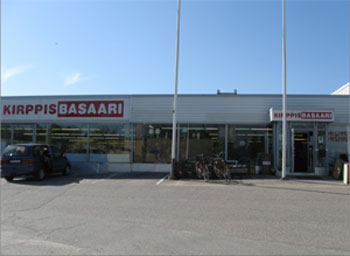 I can say that I have always open “radar”. I’m looking and looking, and I can find and enjoy.
I can say that I have always open “radar”. I’m looking and looking, and I can find and enjoy.
As you know Reyne, I love flea markets and antique shops. I am an old goods “junkie” 🙂
A few years ago I did the best finds at flea markets. Today, the best hunting arena is private people. They have a genuine and good stuff, no junk stuff. People know prices are so cheap it is difficult to get. My favorite flea market is a “Bazaar” flea market. There have nice staff and these people are smiling. Smile is an important trading tool for me.
RH: I agree that a smile goes a long way, especially if you are about to ask for a better price! Where are the best bargains found?
Places where I can find cheapest…..TOP 10
1- A private person who needs money quickly
2- People’s private yard sales
3- Traditional flea market halls
4- Summer market
5- Internet
6- Newspaper sales announcements
7- Auctions
8- Buying and selling stores
9- Antique shops
10- My home 🙂
RH: Do people go knocking on doors of people’s homes they don’t know in Finland searching for antiques?
Not anymore. Sometimes years ago were traveling dealers. They went
to the house and asked whether they had antiques or old stuff.
Sometimes they gave the booze so that they would be easier to buy.
RH: I had to giggle at the booze reply, but then I started to think about how often opening night at an antique show offers wine or a full bar. Maybe they are on to something!
What was your best find ever?
Marko: I’ve found several good bargains. This one story comes to my mind.
I bought stamps from an old man. There were 30 folders. I paid 100e ($120).
I sell them off on the same day 1500€ ($1850). Good profit, but this comes rarely.
Not the best but the funny purchase was horse carts. I paid them 20€ ($25)
Now they have my yard ornament. Peoples are smiling when they go over my yard.
Marko, thanks for being a good sport and answering all of my questions. I loved the images too!
Bookmark this site – the next installment of Picking with Reyne will be uploaded next week!
Happy Hunting!
Reyne






